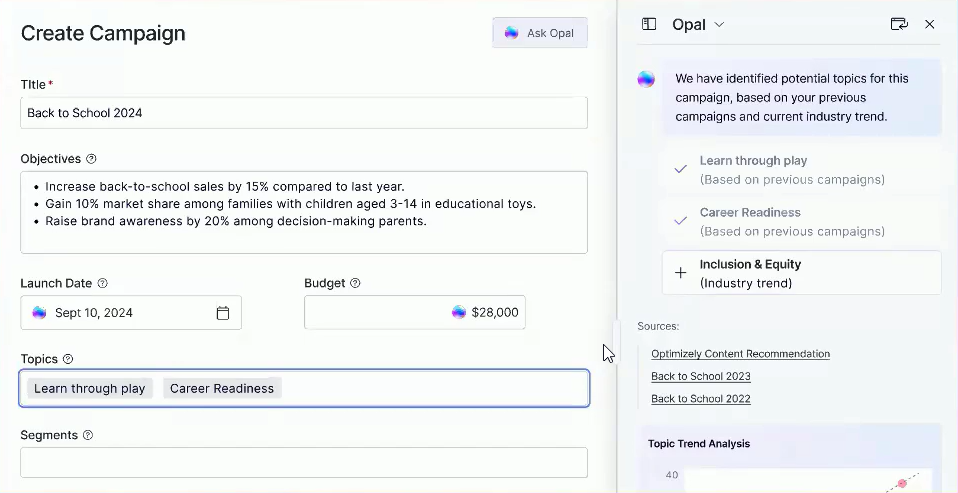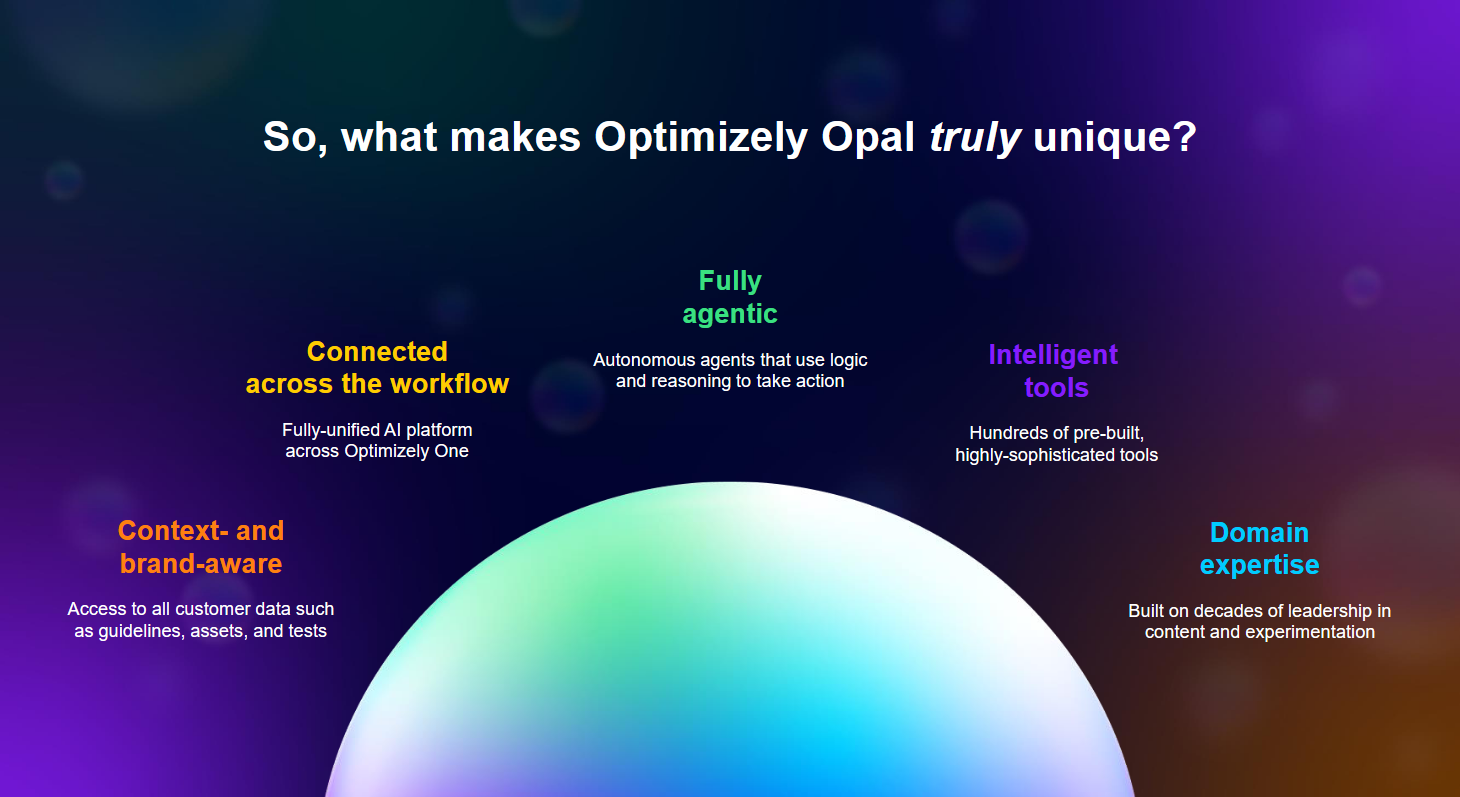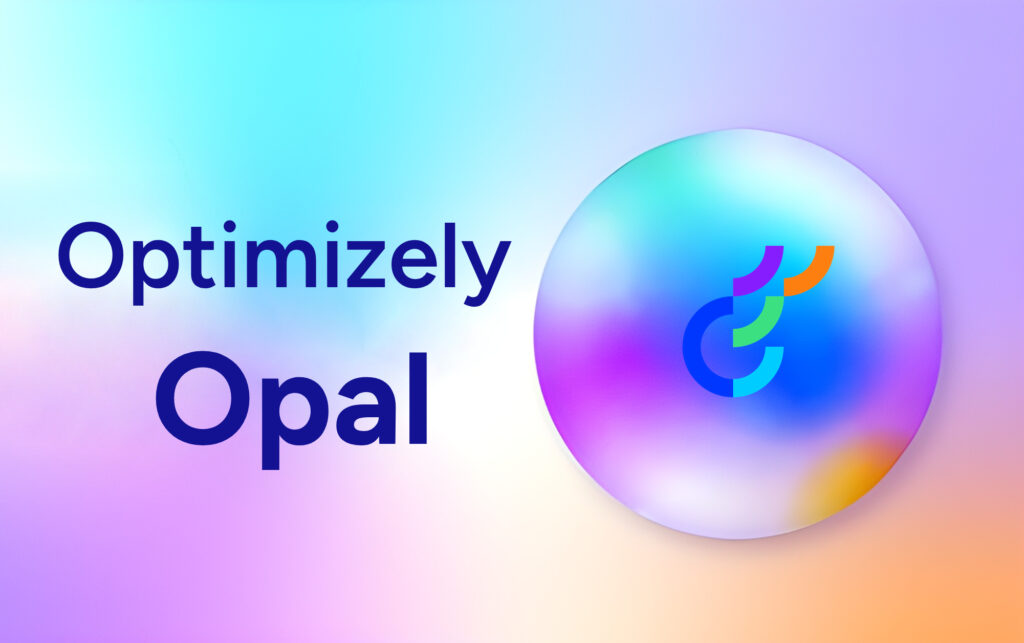Overview
Opal is Optimizely’s AI assistant designed to accelerate and enhance the entire marketing workflow. Integrated natively across OptimizelyOne, Opal helps teams ideate, plan, generate, manage, and optimize content more intelligently and efficiently. This document outlines key features, current capabilities, upcoming enhancements, and how Opal fits into the broader AI-powered content lifecycle.
Opal leverages advanced natural language processing (NLP) and machine learning algorithms to analyze historical campaign data and customer interactions. By identifying patterns and predicting which messaging resonates best with specific audiences, Opal generates tailored content suggestions and optimization tips.
This continuous learning approach allows Opal to adapt to changing trends and provide relevant, data-driven insights, reducing guesswork and accelerating marketing workflows.
Core Capabilities and AI Architecture
Campaign Ideation
Opal assists in generating campaign ideas based on existing content trends and data. Features like objective pre-population and topic suggestions allow content creators to brainstorm and initiate campaigns more quickly, supported by AI insights.


Content Generation
Opal uses AI to generate a wide range of SEO-optimized content such as headlines, product descriptions, and marketing texts for digital channels including web, email, and social media. It adapts outputs to suit different formats and platforms.
The assistant also analyzes user and performance data to suggest relevant topics, headlines, and keywords. This keeps content teams aligned with target audience interests, ensuring messaging remains relevant and effective.
Use cases include:
-
E-Commerce: In e-commerce, OPAL can automatically generate SEO-optimized product descriptions based on features such as color, size, or material, accelerating content creation for large catalogs.
-
Personalized Email Marketing: AI can personalize email campaigns based on user behavior. For example, retail brands can use OPAL to recommend products based on a user’s previous purchases or browsing history.
-
Content Personalization on Websites: AI adapts on-page content in real time. If a user frequently views specific product types, OPAL can display more relevant articles, offers, or recommendations on the homepage.
-
Automatic content generation: OPAL uses AI to create content such as headlines, product descriptions, and texts for various digital channels (web, email, social media). The content is SEO-optimized and adapted to different formats.

Content Optimization
-
Optimizing blogs and articles: AI writing assistants can optimize articles for SEO by analyzing existing content and suggesting better titles, keywords, or structure for higher search visibility.
-
Dynamic Ad Personalization: OPAL can dynamically adjust displayed ads based on user interests and behavior, showing relevant offers or discounts in real time.
-
A/B Testing: OPAL supports running content A/B tests, like testing different headlines, CTAs, or images—and automatically optimizes based on performance data.

Personalization
Opal dynamically adapts content in real time using behavioral signals, demographics, and historical user data. This includes adjusting product displays, banners, and articles to better resonate with individual visitors.
It also supports advanced user segmentation based on preferences, behavior, and past engagement, enabling tailored content experiences for distinct audience groups.
Examples include:
-
Dynamic content personalization: OPAL uses AI to adapt content in real time based on user behavior and preferences. Using data such as browsing history, demographics, and previous engagement, it can change product displays, articles, or banners.
-
User segmentation: OPAL enables user segmentation based on behavior, interests, and other data points, allowing different user groups to receive customized content experiences.
AI-Driven Optimization
Opal provides powerful tools for enhancing content performance:
-
Predictive Analytics: By analyzing historical data and behavior trends, OPAL can predict future user behavior. This allows marketers to better plan content strategies and optimize performance.
-
A/B Testing: OPAL supports automated A/B testing, analyzing results and optimizing content in real time. Based on performance, it can recommend the best-performing variant of a page or message.
In advertising, Opal dynamically adjusts visual and text elements in real time to maximize engagement and conversions based on live performance data.
Image Management
Opal improves visual content handling with:
-
AI Tagging: Automatically categorizes images by analyzing visual elements.
-
Smart Focal Points: Centers key parts of an image (like faces) based on visual weight and channel dimensions, ensuring optimal rendering across responsive designs.
-
Great for responsive image handling across channels.
DAM Integration
With Opal’s integration into Digital Asset Management (DAM), users benefit from smart tagging, AI-assisted batch uploads, and faster asset search and retrieval, all of which streamline content organization and reuse.
CMS Integration
OPAL seamlessly integrates with Optimizely CMS, enhancing content creation and delivery with AI:
AI-Driven Content Personalization and Generation:
-
OPAL can generate and recommend content directly within the CMS, including headlines, descriptions, images, and more, tailored to user data and behavioral signals.
Instruction-Driven Personalization and Governance:
- Within CMS and across the platform, Opal supports “Instructions”, plain-text rules that guide AI behavior. For example, marketers can define brand tone, compliance boundaries, or channel-specific preferences, ensuring every output aligns with strategic goals. These rules are easy to manage without requiring developer support.
A/B Testing and Optimization Inside CMS:
-
CMS users can perform A/B testing directly within the interface, with OPAL analyzing results and recommending the best-performing content variation (e.g., CTA buttons, titles, images).
Automated Workflows:
-
When combined with CMS, OPAL enables end-to-end automation of content creation, optimization, and publishing, significantly reducing manual workload.
AI-Powered Personalization:
-
Optimizely CMS supports real-time AI-driven personalization across channels (web, mobile, email, ads). Through OPAL, content dynamically adapts based on each user’s profile and interaction history.
Nothing lost in translation
-
Translate content within the CMS utilizing AI and machine translation.
-
Translation without rebuilding content structures
Agentic AI & Workflow Automation
Opal is more than a chatbot, it’s a fully agentic platform. Users can create or deploy pre-built autonomous agents that perform advanced tasks on their behalf. These agents can be sequenced into workflows, running in parallel or triggered by chat, schedules, or events. This enables dynamic campaign planning, automated experimentation, and adaptive content deployment with minimal manual intervention.
Opal in the Content Lifecycle
Opal supports the entire content lifecycle, ensuring consistent AI enablement at each step:

AI Architecture & Tech Stack
In addition to its partnership with Google Gemini, Opal operates on a deeply integrated AI layer within Optimizely One. This includes unified access to campaign history, customer data (like brand assets), analytics, and contextual signals, allowing for rich enrichment and minimal hallucinations in AI outputs. Tools and agents access a shared library of capabilities such as image analysis, document summarization, web browsing, and data transformation.
Upcoming Features (Roadmap Highlights)
| Feature | Status | Description |
|---|---|---|
| Campaign Ideation UI | Coming Soon | UI for AI-generated campaign suggestions in CMP |
| Suggested Segments | Beta | Intelligent segment suggestions based on past campaign data |
| AI Agents & Task Creation | Private Beta | Auto-create tasks, assign users, and manage campaigns dynamically |
| Resource Manager | ETA: Late 2025 | AI-assisted workload and resource allocation across campaigns |
| Auto-Localization | Planned | AI detection of translatable content and automatic localization workflows |
| Compliance Guardrails | Planned | Automated compliance checks for content based on predefined rules |
| Agent Workflows | Coming May 2025 |
Compose multi-step workflows with multiple agents working in parallel or sequence
|
Integration with OptimizelyOne
Opal works seamlessly across OptimizelyOne, including:
-
CMP (Content Marketing Platform)
-
DAM (Digital Asset Management)
-
Experimentation & A/B Testing
-
Analytics (NetSpring integration for insights)
It enables brand-specific tone adjustments, unified content generation across formats, and consistent AI-driven support through the marketing stack.
Strategic Value
Opal provides meaningful value by:
-
Accelerates time-to-market for campaigns and content.
-
Improves accuracy and relevancy through AI-driven suggestions.
-
Reduces manual workload through automation of repetitive tasks.
-
Supports scalability with smart segmentation and workflow enhancements.
Tips for Getting the Most Out of Opal
-
Provide clear input details like target audience and campaign goals to get more relevant AI suggestions.
-
Treat AI-generated content as a starting point and refine it to maintain your brand’s unique voice.
-
Combine Opal’s speed and data insights with human creativity for best results.
-
Use Optimizely’s built-in testing features to A/B test and optimize your campaigns effectively.
Conclusion
Optimizely OPAL offers robust capabilities for AI-based content generation, personalization, and optimization. Through its integration with Optimizely CMS, it allows marketers and content teams to generate, test, and publish personalized content at scale with minimal manual effort. With its predictive analytics and automated workflows, OPAL helps organizations deliver highly relevant, engaging, and conversion-optimized content across all digital channels.

Despite its powerful AI-driven capabilities, Opal is designed to assist, not replace, human creativity and judgment. Users should review AI-generated content to ensure it matches brand tone and compliance standards.
Source: Read MoreÂ
